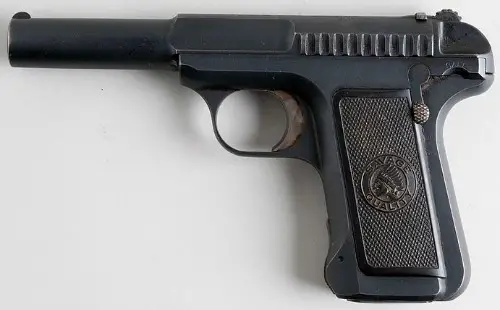|
Savage Pocket Pistols: M1907, M1915 and M1917 By David Tong  The Savage auto pistols were a direct result of the Company's efforts to sell the US Army their first semi-automatic service pistol. These three pistols were the subsequent development. This article describes the common features and differences of the three major variations of this century old design. Commonalities All three are single action only designs produced in .32 ACP and .380 ACP with a slide that rides within the grip frame/receiver. These pistols used a unique, rotating barrel with lugs that ride inside the top of the slide and on the receiver. The barrel rotates only when pressures have dropped sufficiently to allow for safe extraction and ejection. This was probably a needless complication for the standard .32 ACP and .380 ACP versions, as most pistols in these calibers operate on straight blowback principles. A Savage .45 ACP Model 1907 was made only for the the US Army trials and never mass produced. However, some 40,000 .32 ACP Savage pistols were purchased by France and used in the Great War (WW I) and a smaller number were purchased by Portugal. The curious premise of Mr. Ebert Searle's design is that the twist of the bullet moving down the bore was going to be enough of a time delay so the five degree rotation of the barrel in the opposite direction was going to be sufficient to allow this locking principle to reduce slide velocities and recoil. The slide and frame rails are unique in that they angle downward when viewed from the front of the frame above the trigger guard. The removable breechblock is a marvel of early 20th Century American manufacturing genius, but it would probably cost as much as four complete polymer pistols to build today. The pistols were striker fired with double column magazines. The trigger pulls on all three are fairly clean and crisp, but horrifically heavy at well over eight pounds. Coupled with a narrow trigger blade, this means they are difficult to smoothly squeeze for accurate fire. Compounding this are minuscule iron sights that are hard to see even outdoors in daylight. The M1907 is the only one that had a tiny dovetailed rear sight, while the 1915 and 1917 models have a rear sight that is merely an extension machined onto the top of the slide. Reports from the Army pistol trials that led to the selection of the Browning-designed Colt 1911 stated that the Savage had notably more recoil. This was also my experience with the M1915 and the .380 round, even compared to simple blowback designs. Other reports suggest that even the .32 ACP versions had stouter recoil than shooters would normally be accustomed to. All three models have a very low bore axis due to the rotating barrel design, which should help to minimize muzzle flip. The near vertical grip angle increases subjective (felt) recoil. All three models have a unique, front strap mounted, magazine catch that acts like a see-saw, pivoting about a pin and powered by a small spring. The M1907's mag catch operates by depressing the top of the lever, ostensibly with one's ring finger, while the 1915 and 1917 catch works in the opposite direction, by using one's pinky to press inward. The 1907 and 1915 models used molded hard rubber grips that snap into the grip frame's side milled cuts without the need for screws. The M-1917's larger grip frame used more conventional grip panels attached by a single screw. My understanding is that the plastic used in the grip panels for the 1907 and 1915 is difficult to remove and that it is also brittle. I suppose this means that if they are in good condition it would be best to leave them in situ while cleaning. On the top of the slide of all three there is a two line marking. The top line says, "SAVAGE ARMS CO. UTICA, N.Y. USA." The second line reads, "PATENTED NOV. 21, 1905," with a smaller caliber indication of either ".32" or "9 MM" at the end. Differences The Model 1915 is the odd man out. It is the only one of the three that features both a slide hold-open catch, located for a right handed shooter's trigger finger pressing upward to return the slide into battery with a loaded magazine in place. The 1915 is the only one without a spur to allow a shooter to lower the striker to a de-cocked position, as well as the only one to have a grip safety. The 1907 has a rowel type spur that is connected directly to the striker by a cross pin, while the 1917 has a more conventional looking spur that is a bit easier to manipulate. The coil spring on either of them is stout, undoubtedly adding to the trigger pull weight as much as the "up and over" geometry of the trigger's interface with the sear, which is mounted on the breechblock assembly. Since all three of these pistols are collectors' items and a century old, I declined to shoot any, except for the one my family owns. The M1915 was loaded with reloads using 3.6 grains of W231 ball powder and a 95 grain Sierra RN-FMJ bullet, for a nominal velocity of 945 fps. This closely duplicates factory ballistics. The rounds were taper crimped and overall length was confirmed by dial caliper. I only fired two nine round magazines and the sharp recoil was all out of proportion to the cartridge's power. This, the very heavy single-action trigger pull and tiny sights made it problematic to shoot the pistol accurately even at thirty-foot range from a rest. Also, the last round in the magazine mis-fed both times, and I am not sure why. (Happenstance?) I am glad to have had the opportunity to handle and photograph these pieces of American manufacturing history and provide a brief overview of how they work. |